CORNELL HISTORY
What's in a name? The stories behind the buildings and byways of Cornell

Olive Tjaden Hall

Tjaden Hall originally opened in 1883 as Benjamin Franklin Hall and housed the Department of Electrical Engineering.
To the thousands of students and alumni who traverse campus every semester, many of the names on buildings are just that – names. But for those who look beyond the names as mere labels on a map, every location tells a story.
Campus names immortalize generous alumni, honor beloved faculty and staff, and recognize individuals who helped shape Cornell into the university it is today. While some may be familiar to the average Cornellian, like White Hall or Lincoln Hall (named for Cornell co-founder Andrew Dickson White and U.S. President Abraham Lincoln), others are likely more obscure.
When Cornell University opened its doors to students in 1868, the two buildings on what would become the Arts Quad were simply called South University and North University. But the next building to join them was McGraw Hall, a gift of trustee John McGraw that set the precedent for naming buildings after benefactors. It wasn't until 1883 that the Cornell Board of Trustees voted to rename the two original buildings to honor two men who had helped create Cornell: U.S. Congressman Justin Morrill, who sponsored the Morrill Land Grant College Act, and President Andrew Dickson White. Buildings like Morrill Hall and Lincoln Hall recognize national figures who, although not directly associated with Cornell, played a role in its founding. It was Lincoln who signed the Morrill Act in 1862, paving the way for Cornell's founding.

A few of the faces of scientists who appear around Olive Tjaden Hall's faŤade. Tjaden Hall originally opened in 1883 as Benjamin Franklin Hall and housed the Department of Electrical Engineering. See larger image
Those who take a closer look at Tjaden Hall, the Department of Art building in the northwest corner of the Arts Quad, might wonder why the names and faces of famous scientists adorn the brick walls, from Ampere and Bunsen to Galileo and Newton. Opened in 1883, this structure was once home of the country's first Department of Electrical Engineering and was appropriately named Benjamin Franklin Hall to honor "America's first electrician." In 1980, nearly a century later, the trustees voted to rename it in honor of Olive Tjaden Van Sickle '25, a pioneering woman architect with more than 2,000 buildings to her credit who generously funded the building's renovation.
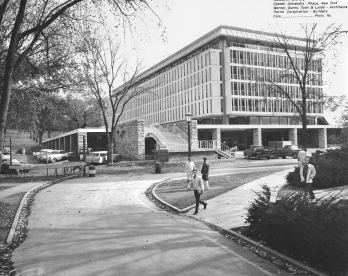
Olin Library, soon after it opened in the early 1960s. See larger image
Like many campuses around the world, Cornell is plagued by the problem of many buildings sharing the same name. Every fall, stories abound of bewildered new students who finds themselves in the McGraw clock tower searching for a room in McGraw Hall, or searching through Uris Library looking for an economics class in Uris Hall, or wondering why there's a business school in the Johnson Museum of Art. Thanks to one particular family of notable alumni, Cornell is home to four Olin buildings: John M. Olin Library, Franklin W. Olin Jr. Hall for Chemical Engineering and Spencer T. Olin Research Laboratory – as well as Franklin W. Olin Hall, a residence for students at Weill Cornell Medical College in New York City.
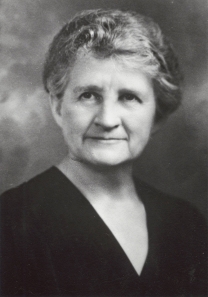
Cornell home economist Flora Rose See larger image
The donors, a father and his two sons, were all Cornellians and university trustees, and the family name adorns buildings across the country, thanks to their philanthropy and trio of personal foundations. A third son, Franklin Jr., died shortly after graduating and was the first to be memorialized with a building given by his father. Family patriarch Franklin W. Olin, Class of 1886, played baseball professionally for two seasons before founding the ammunition manufacturing business that would become the Olin Corp. as it expanded into chemicals, paper products, mining and more.
On West Campus, a quintet of legendary faculty members are recognized by the new house system: labor activist Alice Cook, historian Carl Becker, physicist Hans Bethe, biologist William Keeton and home economist Flora Rose.
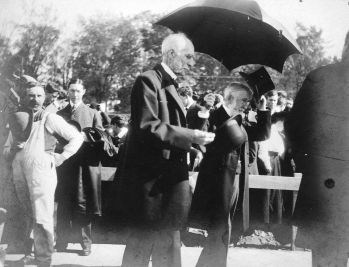
Goldwin Smith and Andrew Dickson White at the opening of Goldwin Smith Hall in 1906. See larger image
Goldwin Smith Hall is another example of a building named after a particularly notable professor. Smith, an expert on English history, was recruited to Ithaca from Oxford by President White shortly after Cornell's founding to add legitimacy and prestige to the fledging university. Similarly, the Ag Quad is almost entirely filled with buildings honoring early faculty and administrators, from the first dean of the College of Agriculture, Isaac Roberts, to the first Cornell provost, Albert Mann, Class of 1904.
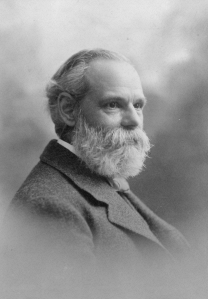
Mechanical engineering professor and dean Robert H. Thurston See larger image
But it's not just buildings on campus that honor Cornellians. A trip through North Campus takes visitors along Thurston Avenue, named for Robert H. Thurston, the first president of the American Society of Mechanical Engineers, who was recruited to Cornell in 1885 to be director of the Sibley School of Mechanical Engineering. Jessup Road – which goes past Mary Donlon Hall (named for the Class of 1920 federal judge and trustee) and Robert Purcell Community Center (named for the Class of 1932 businessman and trustee chairman) – is one of the few campus locations named for a nonacademic staff member. George Jessup, Class of 1908, had a successful career as a dam engineer; in his "retirement" he joined the Cornell staff, where he was project engineer on university construction projects, including many of the North Campus residence halls.
In the last decade, Cornell's most generous alumni and friends have continued to give their names to structures, with the opening of Duffield Hall (David Duffield '62), Weill Hall (Joan and Sanford I. Weill '55) and Milstein Hall (Paul, Irma and Howard Milstein '73).
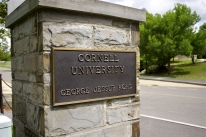
Sign marking George Jessup Road on North Campus See larger image
The next time you pass through campus, take a moment to contemplate the people behind the names all around you, for behind every named building there was a person who loved Cornell or was critical in helping it to prosper.
Corey Ryan Earle '07, the 13th Cornellian in his family and a Cornell history buff, is associate director of student programs in the Office of Alumni Affairs.